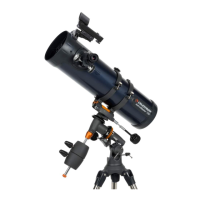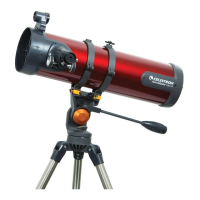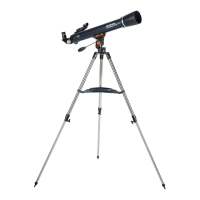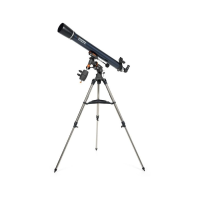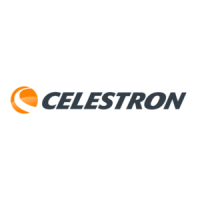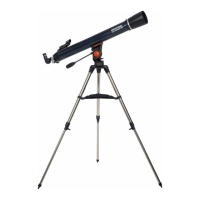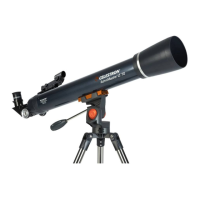Do you have a question about the Celestron AstroMaster 114EQ and is the answer not in the manual?
Important safety precautions to prevent eye damage and equipment harm during telescope use.
Instructions for correctly assembling and extending the tripod for stability.
Guide on how to mount the equatorial mount onto the tripod head for proper operation.
Steps to attach the counterweight bar and weights for balancing the telescope.
Procedure for connecting slow-motion cables for fine telescope adjustments.
Detailed instructions for securely mounting the telescope optical tube onto the equatorial mount.
Steps for inserting the diagonal and eyepiece into the refractor telescope.
Guide for attaching eyepieces to the Newtonian telescope's focuser.
How to manually move the telescope for rough and fine adjustments using locking knobs and cables.
Procedure to balance the telescope mount in the Right Ascension axis for accurate tracking.
Steps to balance the telescope mount in the Declination axis to prevent sudden movements.
Instructions for adjusting the equatorial mount for polar alignment.
How to adjust the mount's altitude setting for proper polar alignment.
Explanation of how image orientation changes based on telescope type and eyepiece setup.
Method for achieving sharp focus on celestial or terrestrial objects using the focus knob.
Procedure to align the Star Pointer finderscope with the main telescope for accurate pointing.
Formula and explanation for determining the magnification of the telescope based on eyepieces.
How to calculate the true angular field of view using eyepiece and magnification data.
Tips for optimal viewing, including avoiding window glass and heat waves.
Explanation of the celestial coordinate system (RA and Dec) used for locating objects in the sky.
Description of how stars appear to move across the sky due to Earth's rotation.
Method for polar aligning the telescope using latitude and mount adjustments.
Using Polaris as a guide to point the telescope's polar axis towards the North Celestial Pole.
How to locate the North Celestial Pole using star patterns like the Big Dipper and Polaris.
Instructions for polar alignment in the Southern Hemisphere, focusing on the South Celestial Pole.
Using Sigma Octantis as a guide for polar alignment in the Southern Hemisphere.
Method to find the South Celestial Pole using star patterns like the Southern Cross.
Procedure to align the Right Ascension (RA) setting circle for accurate celestial object finding.
Tips for observing the Moon, including optimal phases and filter use.
Guidance on observing planets like Venus, Mars, Jupiter, and Saturn, including factors affecting detail.
Critical safety precautions and methods for observing the Sun safely with a solar filter.
Advice for viewing deep-sky objects like nebulae and galaxies, emphasizing dark sky locations.
Explanation of atmospheric conditions (transparency, sky illumination, seeing) affecting viewing quality.
Introduction to prime focus astrophotography, including polar alignment and motor drive use.
Method for capturing wide-field celestial images using a camera mounted on top of the telescope.
Overview of modern technology for capturing high-quality planetary and lunar images.
Discussion of CCD cameras for capturing detailed deep-sky images.
Using the telescope as a telephoto lens for landscape and wildlife photography.
Guidelines for safely cleaning telescope optics, including lens cleaners and dust removal.
Process of aligning the optical elements of a Newtonian telescope for optimal performance.
Celestron Sky Maps guide for learning the night sky and locating celestial objects.
Economically priced eyepieces offering sharp views across the entire field with various focal lengths.
A 2x Barlow lens that doubles the magnification of any eyepiece for increased viewing power.
An eyepiece filter to reduce moon brightness and improve contrast for better lunar detail.
Filter to enhance deep sky viewing from urban areas by reducing light pollution.
Celestron flashlight with red LEDs to preserve night vision, featuring adjustable brightness.
Accessory for easily collimating Newtonian telescopes, includes detailed instructions.
A specialized eyepiece ideal for achieving precise collimation of Newtonian telescopes.
Universal adapter for mounting digital cameras to telescopes for afocal photography.
Adapter to fit telescope focuser, allowing attachment of 35mm SLR cameras for photography.
Single axis RA motor drive that compensates for Earth's rotation to keep objects in view.
Details on the optical design of the AstroMaster telescopes, including refractor and Newtonian types.
The diameter of the main lens or mirror, which determines light-gathering ability and resolution.
The distance from the lens/mirror to the point where light is focused, affecting magnification and field of view.
The ratio of focal length to aperture, indicating the telescope's speed and field characteristics.
Percentage of light blocked by the secondary mirror in Newtonian reflectors, affecting contrast and brightness.
Information on the anti-reflective coatings applied to optical elements for improved light transmission.
Specification of the type of finderscope included with each AstroMaster model.
Details about the included 1.25-inch diagonal for refractor models.
Information on the included 1.25-inch eyepieces, including magnification and field of view.
The actual angular field of view provided by the 20mm eyepiece.
The linear field of view in feet per 1000 yards using the 20mm eyepiece.
Specifies the type of mount used for the AstroMaster series, e.g., Equatorial CG2.
Indicates whether the mount is equipped with Right Ascension and Declination setting circles.
Confirms the presence of slow-motion cables for precise tracking adjustments on the mount.
The diameter of the tripod legs, indicating stability and build quality.
Confirms the inclusion of the 'The Sky' Level 1 astronomy software.
The maximum recommended magnification for optimal viewing with each telescope model.
The faintest star magnitude the telescope can detect under ideal conditions.
The theoretical resolving power of the telescope in arc seconds, based on the Rayleigh criterion.
The practical resolving power of the telescope in arc seconds, based on Dawes' limit.
Compares the light-gathering capability of each model relative to the human eye.
The physical length of the telescope optical tube for each model.
The total weight of the telescope and mount assembly for each model.
Important safety precautions to prevent eye damage and equipment harm during telescope use.
Instructions for correctly assembling and extending the tripod for stability.
Guide on how to mount the equatorial mount onto the tripod head for proper operation.
Steps to attach the counterweight bar and weights for balancing the telescope.
Procedure for connecting slow-motion cables for fine telescope adjustments.
Detailed instructions for securely mounting the telescope optical tube onto the equatorial mount.
Steps for inserting the diagonal and eyepiece into the refractor telescope.
Guide for attaching eyepieces to the Newtonian telescope's focuser.
How to manually move the telescope for rough and fine adjustments using locking knobs and cables.
Procedure to balance the telescope mount in the Right Ascension axis for accurate tracking.
Steps to balance the telescope mount in the Declination axis to prevent sudden movements.
Instructions for adjusting the equatorial mount for polar alignment.
How to adjust the mount's altitude setting for proper polar alignment.
Explanation of how image orientation changes based on telescope type and eyepiece setup.
Method for achieving sharp focus on celestial or terrestrial objects using the focus knob.
Procedure to align the Star Pointer finderscope with the main telescope for accurate pointing.
Formula and explanation for determining the magnification of the telescope based on eyepieces.
How to calculate the true angular field of view using eyepiece and magnification data.
Tips for optimal viewing, including avoiding window glass and heat waves.
Explanation of the celestial coordinate system (RA and Dec) used for locating objects in the sky.
Description of how stars appear to move across the sky due to Earth's rotation.
Method for polar aligning the telescope using latitude and mount adjustments.
Using Polaris as a guide to point the telescope's polar axis towards the North Celestial Pole.
How to locate the North Celestial Pole using star patterns like the Big Dipper and Polaris.
Instructions for polar alignment in the Southern Hemisphere, focusing on the South Celestial Pole.
Using Sigma Octantis as a guide for polar alignment in the Southern Hemisphere.
Method to find the South Celestial Pole using star patterns like the Southern Cross.
Procedure to align the Right Ascension (RA) setting circle for accurate celestial object finding.
Tips for observing the Moon, including optimal phases and filter use.
Guidance on observing planets like Venus, Mars, Jupiter, and Saturn, including factors affecting detail.
Critical safety precautions and methods for observing the Sun safely with a solar filter.
Advice for viewing deep-sky objects like nebulae and galaxies, emphasizing dark sky locations.
Explanation of atmospheric conditions (transparency, sky illumination, seeing) affecting viewing quality.
Introduction to prime focus astrophotography, including polar alignment and motor drive use.
Method for capturing wide-field celestial images using a camera mounted on top of the telescope.
Overview of modern technology for capturing high-quality planetary and lunar images.
Discussion of CCD cameras for capturing detailed deep-sky images.
Using the telescope as a telephoto lens for landscape and wildlife photography.
Guidelines for safely cleaning telescope optics, including lens cleaners and dust removal.
Process of aligning the optical elements of a Newtonian telescope for optimal performance.
Celestron Sky Maps guide for learning the night sky and locating celestial objects.
Economically priced eyepieces offering sharp views across the entire field with various focal lengths.
A 2x Barlow lens that doubles the magnification of any eyepiece for increased viewing power.
An eyepiece filter to reduce moon brightness and improve contrast for better lunar detail.
Filter to enhance deep sky viewing from urban areas by reducing light pollution.
Celestron flashlight with red LEDs to preserve night vision, featuring adjustable brightness.
Accessory for easily collimating Newtonian telescopes, includes detailed instructions.
A specialized eyepiece ideal for achieving precise collimation of Newtonian telescopes.
Universal adapter for mounting digital cameras to telescopes for afocal photography.
Adapter to fit telescope focuser, allowing attachment of 35mm SLR cameras for photography.
Single axis RA motor drive that compensates for Earth's rotation to keep objects in view.
Details on the optical design of the AstroMaster telescopes, including refractor and Newtonian types.
The diameter of the main lens or mirror, which determines light-gathering ability and resolution.
The distance from the lens/mirror to the point where light is focused, affecting magnification and field of view.
The ratio of focal length to aperture, indicating the telescope's speed and field characteristics.
Percentage of light blocked by the secondary mirror in Newtonian reflectors, affecting contrast and brightness.
Information on the anti-reflective coatings applied to optical elements for improved light transmission.
Specification of the type of finderscope included with each AstroMaster model.
Details about the included 1.25-inch diagonal for refractor models.
Information on the included 1.25-inch eyepieces, including magnification and field of view.
The actual angular field of view provided by the 20mm eyepiece.
The linear field of view in feet per 1000 yards using the 20mm eyepiece.
Specifies the type of mount used for the AstroMaster series, e.g., Equatorial CG2.
Indicates whether the mount is equipped with Right Ascension and Declination setting circles.
Confirms the presence of slow-motion cables for precise tracking adjustments on the mount.
The diameter of the tripod legs, indicating stability and build quality.
Confirms the inclusion of the 'The Sky' Level 1 astronomy software.
The maximum recommended magnification for optimal viewing with each telescope model.
The faintest star magnitude the telescope can detect under ideal conditions.
The theoretical resolving power of the telescope in arc seconds, based on the Rayleigh criterion.
The practical resolving power of the telescope in arc seconds, based on Dawes' limit.
Compares the light-gathering capability of each model relative to the human eye.
The physical length of the telescope optical tube for each model.
The total weight of the telescope and mount assembly for each model.
| Aperture | 114 mm |
|---|---|
| Focal Length | 1000 mm |
| Focal Ratio | f/8.77 |
| Mount Type | Equatorial |
| Optical Design | Newtonian Reflector |
| Highest Useful Magnification | 269x |
| Lowest Useful Magnification | 16x |
| Limiting Stellar Magnitude | 12.8 |
| Resolution (Rayleigh) | 1.22 arc seconds |
| Resolution (Dawes) | 1.02 arc seconds |
| Light Gathering Power | 265x |
| Eyepieces Included | 20 mm (50x), 10 mm (100x) |
| Finderscope | StarPointer |
| Optical Coatings | Aluminum |
| Tripod | Steel |
| Weight | 17 lbs |


